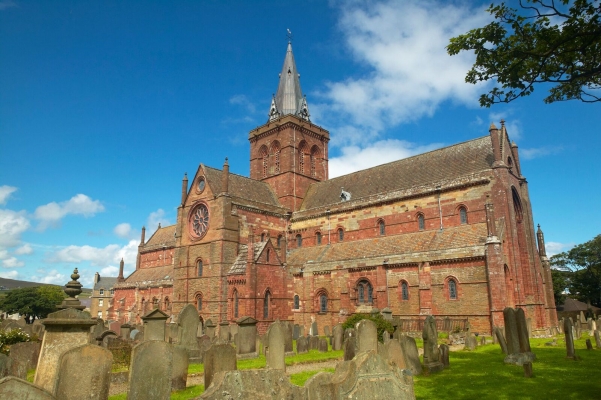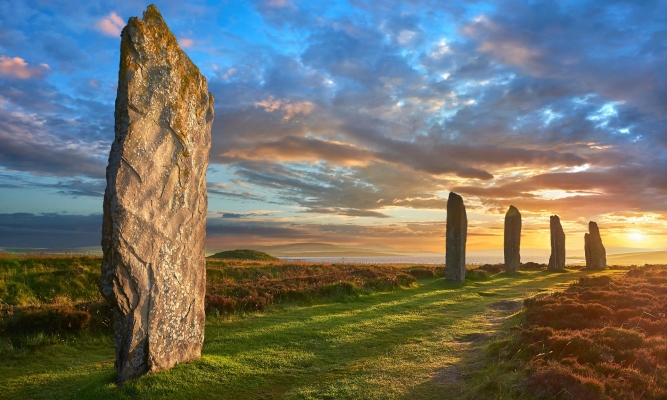Orkney Islands Itinerary
1st November 2022
The distant lands of Orkney! In our last blog we asked our Driver Guides to name their favourite places to visit in Scotland and the Orkney Isles were a popular choice. So we thought we would tell you about all the incredible sites we can include in your itinerary if you book a tour of the Orkney Islands.
Orkney is an archipelago of 70 islands and skerries (mini islands), full of beautiful beaches, heritage, culture and ancient history. It is also one of the furthest away vacation destinations from Scotland’s central belt. To get there we drive to the very north of Scotland and then take a boat across to the Islands. We wouldn’t recommend Orkney to those with limited time; ideally you’ll need at least 10 days in Scotland including two days on the islands themselves.
Our 12 Day Outer Hebrides, Neolithic Orkney & Highlands Tour is the perfect length for visiting Orkney, along with plenty of other great stops across the Scottish highlands and islands.
You may have seen that some tour companies will run one-day tours from Inverness to Orkney. This isn’t something we do as it doesn’t give you enough time to really experience the amazing places these islands have to offer. But enough of the logistics… let us tell you about our favourite places on Orkney!

The Orkney Coastline - Driver Terry
Orkney Day 1
The Ferry Crossing
To get to Orkney, we’ll take the Pentland Ferry, crossing from Gills Bay in Caithness to St Margaret’s Hope in South Ronaldsay, which takes around 1 hour. It is a fairly relaxed trip (if the seas aren’t too choppy!) and there is food and drink available on board. Sit back, enjoy a cup of tea, and look out the window at the magical views. Even after many years of touring, our Drivers still feel a sense of wonder as we cruise into the Orkney Archipelago.
The Italian Chapel and the Churchill Barriers
No Orkney itinerary would be complete without a visit to the Italian Chapel. To get to the Chapel we drive across the Churchill Barriers, built in 1940 to provide protection to boats stationed off Orkney’s coast. In 1939, during WW2, a German U-boat was able to access Scapa Flow (the waters between Orkney’s islands) and fired onto the HMS Royal Oak which sunk, resulting in the deaths of the 834 crew members. The idea of the Churchill Barriers was to block entry from the East preventing further attacks by sea. Today they act as important road connections between the islands.
Work on the causeways was slowing due to lack of manpower, so Churchill shipped a group of Italian prisoners of war to Orkney to help with the build. Once Italy converted to the Allied forces, these men ceased to be POWs and were paid for their work. At this point, they demanded a proper place of worship, and this is the origin of the magnificent Italian Chapel.
The chapel is built from cheap and scrap materials, being mainly constructed from tin sheets and two Nissen huts (army barracks). But as we know, the Italians are true artists at their core, so they didn’t let a lack of expensive materials compromise the beauty of their design.
Before you head to your next stop, you’ll need some grub! The Foveran is close by and both the food and the views are excellent!
St Magnus Cathedral
The next cathedral on our itinerary is St Magnus Cathedral, the ‘Light in the North’. This is a much older cathedral - the original structure was built in 1137, with many further aspects of the building added over the next few centuries. It was built by Vikings, known as the Norse Earl’s of Orkney, including of course, St Magnus. The Cathedral consists of red and yellow sandstone in the Romanesque style, and it is the most northerly cathedral in the UK.
Next to the Cathedral, you’ll find Bishop’s Palace and Earl’s Palace built in the 12th and 16th centuries respectively. These are some of the best-preserved ancient buildings in Orkney. You will have a great time exploring the buildings and learning about the history of life on the islands.

St Magnus Cathedral - Driver Terry
Highland Park Distillery
“Far Away in the storm-lashed Orkney Islands is the place where magic happens.” - www.highlandparkwhisky.com/en/distillery
What better way to end your first day on Orkney, than with a whisky tour and tasting at the world-famous Highland Park Distillery? These striking stone buildings have been distilling Whisky for over two hundred years, and their process has remained pretty much the same throughout that time.
Overnight Stay on Orkney
We usually spend two or three nights staying on Orkney and one of our favourite hotels is The Storehouse in Kirkwall. The Storehouse has been renovated to a very high standard and you will find unique and original details throughout. For your evening meal, you will enjoy delicious local Orkney produce.
Please note that we can’t guarantee you will stay in any particular hotel but the earlier you book, the more choice we will have when arranging your accommodation. There are many other lovely hotels in Orkney to choose from.
Orkney Day 2
The Heart of Neolithic Orkney
Day 2 is a busy day with many historical sites to visit. Our first stop is the Heart of Neolithic Orkney UNESCO World Heritage Site which contains four fascinating, ancient structures.
The first we will visit is Maeshowe, the grandest chambered tomb on Orkney, built using impressive Stone Age construction techniques. Look around the tomb and you’ll spot the 12th century graffiti left by Viking raiders!
A few minutes along the road you will find the Stones of Stenness; a 5,000 year old ceremonial stone circle (making them older than Stonehenge!) In the centre of the main circle, there is a smaller stone circle on which archaeologists have found the remains of ancient, cremated pottery and bones - eek!
Next, we will head to the Ring of Brodgar, of which you may have already seen photos. Not thought to be quite as old as the Stones of Sternness, but what they lack in years, they more than make up for in eerie splendour. These dramatic standing stones have an air of ceremony and mysticism. The stones were placed around 2,500-2,000BC making this ritual site over 4,000 years old and they cover a large area of 8,500 square metres.
Between the Stones of Stenness and the Ring of Brodgar, there is an archaeological excavation site which is uncovering even older buildings thought to have been inhabited around 3,000BC. Archaeologists have so far discovered a vast complex of at least three hectares of Neolithic dwellings.
Our final stop in the UNESCO site is Skara Brae, the best-preserved Neolithic settlement in Western Europe, also around 5,000 years old. Some of the pottery found at the ceremonial centre of the Stones of Stenness has been linked to pottery found within Skara Brae. There are 9 preserved houses for you to explore and artefacts such as dice, tools and jewellery can be viewed in the nearby visitor centre.
Broch of Gurness
After lunch, we head across to the opposite coast of Kirkwall to visit the Broth of Gurness, one of the most outstanding examples of a prehistoric settlement. You won’t believe how intact this Iron Age Broch village is until you see it for real!

Broch of Gurness - Driver Terry
Rendall Doocot
Have you ever eaten pigeon? Not too far from the Broch, you’ll find Rendall Doocot, a large 17th century stone structure used to store pigeons. The pigeons were cooked and eaten by the residents in the nearby Hall of Rendall. This is a favourite spot of our Driver Terry who is a pigeon enthusiast and loves showing his guests this unusual structure, which is still a nesting site for pigeons today. Although if you are scared of birds… this is one to avoid!
Brough of Birsay
Our final stop is the Brough of Birsay - accessible only during low tides. The Brough of Birsay is home to the remains of a busy complex of Pictish, Norse and some newer settlements. Birsay Bay is also one of Orkney’s many beautiful beaches. If beaches are your thing, Dingieshowe, Scappa Beach and the Sands of Evie are all worth a visit.
Touring Orkney
A tour of the Orkney Archipelago is one of the most interesting in the whole of Scotland and if you have the time, we highly recommend you visit during your vacation. To enjoy Orkney to the full, you’ll need to stay on the islands for a minimum of two nights.
We would also suggest that you stick to visiting Orkney between late April and early October. The Scottish ferries are sometimes cancelled during the winter due to bad weather, so our winter tours avoid the majority of the Scottish islands. The exceptions to this are Skye (accessible by a road bridge) and Mull which has a more reliable ferry crossing. These are great island alternatives for a winter tour.
The majority of our tours which include a trip to Orkney leave from Edinburgh or Glasgow. However, if you would like to be collected from another location such as Inverness, please get in touch with our team to discuss your route. Whatever your requirements, we will create an itinerary that works for you.
See you in Orkney!
Recent articles





